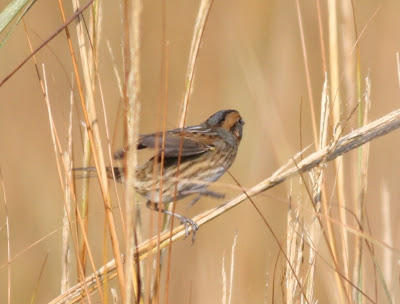"Interior" Nelson's Sparrow - alterus or nelsoni?
UPDATE 11/3 - Julian has made a blog posting with his photos and thoughts on this bird, so check it out. Included are thoughts from Fletcher Smith, author of the recent NAB article on the sharp-tailed sparrows, who agrees this bird fits alterus best.
ORIGINAL POST: Yesterday at Hammonasset Beach State Park in Madison, CT Julian Hough and I observed this bright Nelson's Sparrow, clearly representing one of the interior races. It is quite unlike the drab, gray-toned Acadian subvirgatus subspecies that breeds not far up the Atlantic coast to our north. All photos are untouched - only cropped.
ORIGINAL POST: Yesterday at Hammonasset Beach State Park in Madison, CT Julian Hough and I observed this bright Nelson's Sparrow, clearly representing one of the interior races. It is quite unlike the drab, gray-toned Acadian subvirgatus subspecies that breeds not far up the Atlantic coast to our north. All photos are untouched - only cropped.
Nelson's Sparrow, likely alterus
Separating alterus from nelsoni during migration is a difficult task. A recent article in North American Birds states that approximately 30% of interior birds banded in Virginia during the nonbreeding season could not be assigned to subspecies given current knowledge. If they're tough in the hand, they're tougher in the field.
Here are some notes:
- high-contrast facial pattern with bright orange triangle and gray auricular
- clean orange supercilium without internal markings
- broad, clean gray central crown stripe, generally lacking internal markings
- white braces down the back bordered by brown (not black)
- wing coverts edged with warm brown that look rufous-toned in some shots
- yellow-ochre flanks and breast band filled with bold brown streaking...weakest at the central breast, boldest and brownest down the flanks
- contrasting white belly
- whitish throat that has a hint of pale yellow-ochre color to it
I am not sure that this bird, from these photographs, can be certainly assigned to either interior subspecies. But, some plumage features seem to indicate alterus over nelsoni (namely the back pattern and broad, unmarked central crown stripe). Based on geography, alterus is more likely to occur here than nelsoni. The bird's plumage seems to fall within the range of what alterus is capable of, perhaps even flank streaking so bold. The latest photo spread in NAB illustrates a few alterus every bit as bright as this one. If anyone has differing thoughts, please let me know!
- Nick
Here are some notes:
- high-contrast facial pattern with bright orange triangle and gray auricular
- clean orange supercilium without internal markings
- broad, clean gray central crown stripe, generally lacking internal markings
- white braces down the back bordered by brown (not black)
- wing coverts edged with warm brown that look rufous-toned in some shots
- yellow-ochre flanks and breast band filled with bold brown streaking...weakest at the central breast, boldest and brownest down the flanks
- contrasting white belly
- whitish throat that has a hint of pale yellow-ochre color to it
I am not sure that this bird, from these photographs, can be certainly assigned to either interior subspecies. But, some plumage features seem to indicate alterus over nelsoni (namely the back pattern and broad, unmarked central crown stripe). Based on geography, alterus is more likely to occur here than nelsoni. The bird's plumage seems to fall within the range of what alterus is capable of, perhaps even flank streaking so bold. The latest photo spread in NAB illustrates a few alterus every bit as bright as this one. If anyone has differing thoughts, please let me know!
- Nick













A beautiful sparrow for sure! I've yet to see one of those.
ReplyDeleteThis strikes me as a good candidate for a “James Bay” as they are described. It’s certainly not a Saltmarsh or an “Acadian” and I don’t think the braces would be explained by a hybrid which would likely otherwise be brought into the discussion.
ReplyDeleteI’m slowly working on some thoughts about subspecies with regard to this (very different) bird that to my eye doesn’t fit well with “Prairie” (my preferred over “Interior”) and certainly not Saltmarsh, “Acadian” or a hybrid thereof.
https://www.facebook.com/share/1N8tacAnJD/?mibextid=wwXIfr
My working hypothesis has been a possible “James Bay” but if they look like your bird instead who knows! It’s dark and drab and not pale and drab.
It is still in progress but I do have some links in the comments to at least some thoughts regarding the three Nelson’s from Jean Iron for one who describes “James Bay” as “intermediate between “Prairie” and “St. Lawrence”” (“Acadian”).
Dr. Elphick has been in upstate NY focusing on the “Interior Group” this fall and may have some thoughts at some point. Perhaps it might be good to run this past him.
The lack of substantive resources is frustrating to say the least. They’ve been split since 1995 and even Saltmarsh vs “Interior” Nelson’s in fall migration isn’t well described. It does seem that migrant Saltmarsh and “Acadian” can look quite different than in the summer. .
These are unfortunately sparsely populated:
• “Prairie”/“Interior” (𝘈𝘮𝘮𝘰𝘴𝘱𝘪𝘻𝘢 𝘯𝘦𝘭𝘴𝘰𝘯𝘪 𝘯𝘦𝘭𝘴𝘰𝘯𝘪):
https://www.inaturalist.org/taxa/793297-Ammospiza-nelsoni-nelsoni
• “James Bay” (𝘈. 𝘯. 𝘢𝘭𝘵𝘦𝘳𝘢) is especially sparse:
https://www.inaturalist.org/taxa/793287-Ammospiza-nelsoni-altera
• “Acadian Sparrow” (strongly favored along with “Timberline Sparrow” and “Ipswich Sparrow”) (𝘈. 𝘯. 𝘴𝘶𝘣𝘷𝘪𝘳𝘨𝘢𝘵𝘢)
https://www.inaturalist.org/taxa/793288-Ammospiza-nelsoni-subvirgata
And another tricky subspecies pairing is even less populated and more mysterious:
• “Northern” Saltmarsh (𝘈. 𝘤𝘢𝘶𝘥𝘢𝘤𝘶𝘵𝘢 𝘤𝘢𝘶𝘥𝘢𝘤𝘶𝘵𝘢):
https://www.inaturalist.org/taxa/793290-Ammospiza-caudacuta-caudacuta
Vs
• “Southern” (𝘈. 𝘤. 𝘥𝘪𝘷𝘦𝘳𝘴𝘶𝘴)
https://www.inaturalist.org/taxa/719113-Ammodramus-caudacutus-diversus
A quick scan of unspecified Nelson’s revealed at least one fairly terrifying bird from British Columbia:
https://www.inaturalist.org/observations/207675800
https://www.inaturalist.org/observations/200969500
Hybrids are another aspect I’ve been working on:
https://ebird.org/species/x00450
I’m slowly gathering my thoughts with this bird as a hub:
https://www.facebook.com/share/1BdwHwXtkT/?mibextid=wwXIfr
I’ve put both of those projects on hold until I organize and categorize my 𝘈𝘮𝘮𝘰𝘴𝘱𝘪𝘻𝘢 catalog.
Thanks, Patrick!
Delete